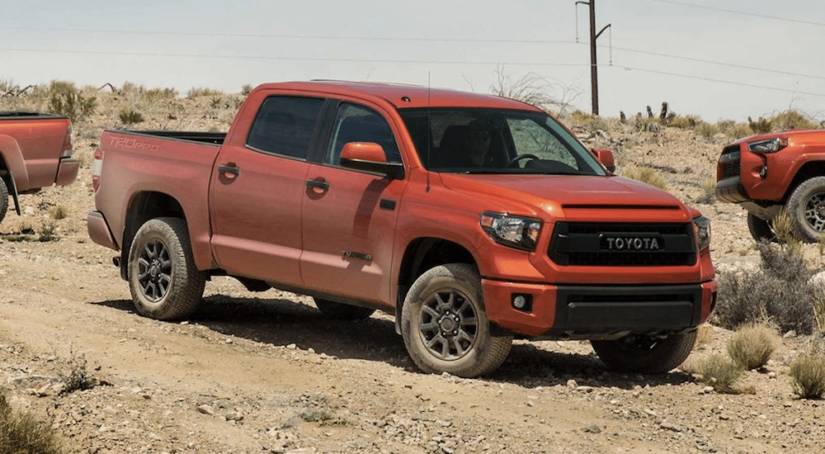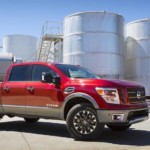Once calendars changed over to the new millennium, it was becoming progressively more clear that the American truck market was going through some changes. By this point the Toyota Tacoma was fairly well-established with five years under its belt, proving that you didn’t have to be Ford, Chevy or GM to churn out a truck worth buying.
This would be further substantiated by the 2000 release of the Toyota Tundra, and the 2004 release of the Nissan Titan. With consistently strong performance (both on-the-road and in sales) these two upstart offerings have served as the proverbial poster-children for the evolving truck segment.
But how do they measure up against one another? Let’s find out by comparing the 2017 Nissan Titan vs 2017 Toyota Tundra. To make this as ‘apples-to-apples’ as it can be, let’s compare the Titan’s SV trim against the Tundra’s SR trim, both with the 4×4 Crew / Double Cab configuration. This sets the pricing to start around $42,595 MSRP for the Titan and $35,165 MSRP for the Tundra. Of course, subjective inclusion of additional features and premium packages will increase the price for each. Pricing won’t factor into this comparison, but we’ll get things started with…
Performance
Regardless of trim level selected, the Nissan Titan SV is powered by a 5.6-liter V8 paired to a seven-speed automatic transmission. Delivering 390 horsepower, 394 lb-ft of torque and 18 mpg combined (21 Highway, 15 City) a properly-equipped 4×4 Titan can tow up to 9230 LBS with a 1610 LB max payload.
Based on the configuration selected, the Toyota Tundra SR is powered by a 5.7-liter V8 paired to a six-speed automatic transmission. Delivering 381 horsepower, 401 lb-ft of torque and 17 mpg combined (19 Highway, 15 City) a properly-equipped 4×4 Tundra can tow up to 10,500 LBS with a 1520 LB max payload.
If our goal was to keep this apples-to-apples, we think we did a pretty good job. In fact, we might have done too good of a job considering the closeness of these performance specs. Overall, the Titan just manages to inch out Tundra in nearly all areas, except for towing capacity. That said, the engine spec for the Titan is the standard configuration for all Titans regardless of trim level. If the Titan already had a small advantage in terms of performance, it also gains points by offering the same (or ‘close-to same’) performance across the board. For that reason, the Titan takes an early lead. (1:0 Nissan).
Exterior Design
Just to reiterate, we’ve opted to compare the Titan SV and Tundra SR with the Crew / Double Cab configurations. With this, both are four-door options with the Titan sporting a 5-foot-7-inch bed and a 6-foot-5-inch bed for the Tundra. Both ride on 18-inch wheels, although the Titan gains alloy wheels over the Tundra’s steel.
In terms of the difference in bed length, I prefer the slightly shorter bed of the Titan. Visually it looks more proportionate overall, and it seems more cohesive with the overall body styling.
With the understanding that unique design notes are part of what sets these trucks apart from their domestic counterparts, aesthetics (no matter how subjective) are a crucial component of their success, or lack thereof.
In my opinion, the Titan SV stands head and shoulders above the Tundra SR. Not only is the Titan a better-looking truck by comparison, it’s a great looking truck overall. From every angle, the strength of the Titan’s aesthetic are striking, in contrast to the uninspired body styling of the Tundra. Enhanced further by the tasteful chrome accents gained at the SV trim level, the Titan is the easy victor in terms of exterior design. (2:0 Nissan)
Interior Design
Both the Titan and the Tundra offer cabins that are spacious, without feeling cavernous. Seating five comfortably, the Tundra does manage to offer rear passengers slightly more room due to its upsized cab dimensions. That said, it’s not enough of a difference to outperform the Titan which also seats five comfortably. This means that it comes down to aesthetics; and any discussion of design aesthetics is going to be subjective.
In my opinion the Tundra interior feels condensed, especially across the gauge cluster and control panel. In some ways appearing to be ‘too modern’ it evokes feelings of crossover SUV interiors which may be pleasing to some, but I feel that it is outclassed by the Titan. The layout of the Titan feels traditional, yet contemporary. It still feels like a truck and (call me crazy, but) that’s an important box to tick. (3:0 Nissan)
Technology
At the SV trim level, the Titan’s infotainment is built around a 5-inch (non-Touchscreen) color display and a six-speaker audio system with satellite radio. Bluetooth-enabled you can stream music, or utilize the CD Player, Auxiliary and USB inputs or stream via NissanConnect mobile apps. Also included is Nissan’s Trailer Sway Control, offering some peace of mind when towing.
Centered around a 6.1-inch touchscreen and six-speaker sound system, the Bluetooth-enabled Tundra SR also allows you to stream music or enjoy it via stereo, CD player, auxiliary and USB inputs. Added convenience comes in the form of the rear camera, and an integrated trailer brake controls for use in towing.
While this is close, it feels appropriate to favor the Tundra based on the inclusion of the progressively more standard touchscreen and rear camera at this particular base level. (3:1 Nissan)
Results
The Titan had all but swept the Tundra at this trim level, but with some smart inclusion of tech amenities the Tundra SR managed to gain some ground. That said, either model has a wealth of amenities available at top-range levels so, with such close performance ratings, we recommend that you take a long look at both and determine which suits your tastes.



